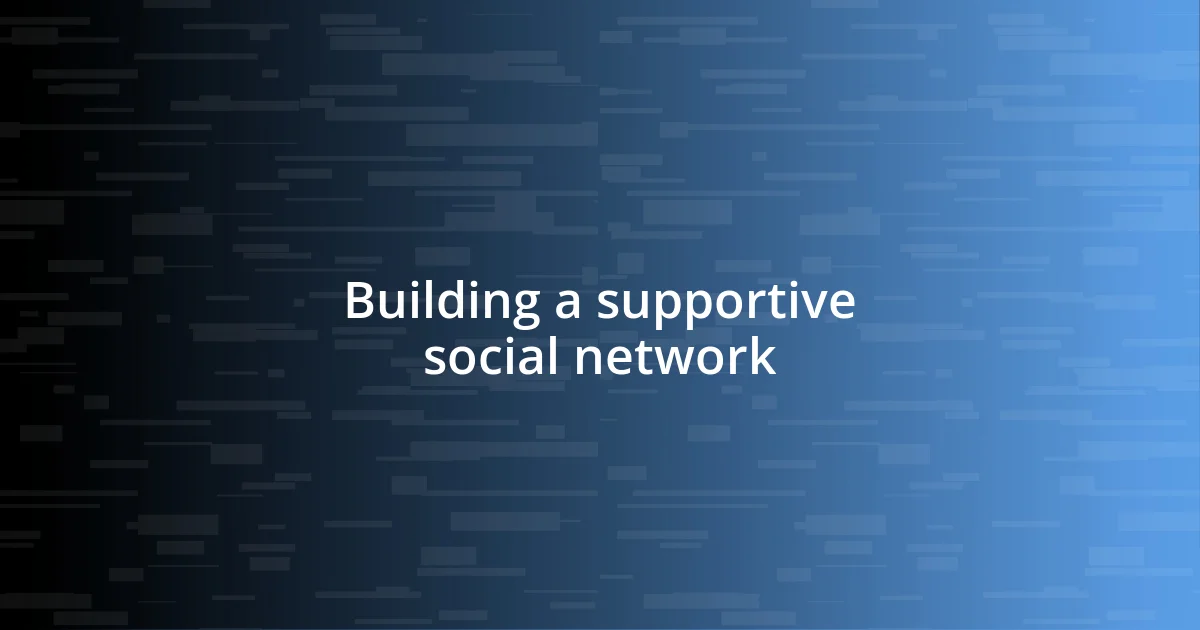Key takeaways:
- Implementing personalized stress relief strategies, such as mindfulness meditation and physical activity, can significantly improve mental well-being.
- Identifying specific stress triggers through reflection and self-awareness enables proactive management of stressors.
- Building a supportive social network enhances coping mechanisms, fostering connection and positivity during challenging times.

Understanding stress relief strategies
Understanding stress relief strategies is essential for maintaining our mental and emotional well-being. I remember a point in my life when the pressures of work and personal commitments felt insurmountable. It was then that I realized how vital it is to identify and implement personalized stress relief methods, tailored to my unique needs.
There is no one-size-fits-all approach to managing stress, as everyone experiences it differently. I often ask myself: what works for me may not work for you, and that’s okay. When I discovered mindfulness meditation, it opened a new door to clarity and relaxation for me. It’s fascinating how a few deep breaths can shift our perspective and provide a moment of calm amid chaos.
Exploring various strategies, like physical exercise or creative hobbies, provided me with valuable insights into what alleviates my stress effectively. Some days, a brisk walk in nature clears my mind, while other days, immersing myself in a good book helps me escape. This journey of trial and error ultimately leads to a deeper understanding of the strategies that resonate with my emotional landscape.

Identifying your stress triggers
Recognizing your stress triggers is a crucial step in managing your well-being. I recall a particularly overwhelming week at work when every little mishap sent me spiraling. It wasn’t until I took a step back that I noticed how specific situations, like tight deadlines or conflicts with colleagues, consistently led to rising stress levels. By pinpointing these stressors, I found I could approach them with more awareness and ultimately, a clearer mind.
To help identify your own triggers, consider:
- Keeping a stress diary: Note down what situations, people, or environments spike your stress.
- Reflecting on past experiences: Think about times when you felt stressed and what led up to those moments.
- Noticing physical responses: Pay attention to your body; how does it react in stressful situations? Tension, rapid heartbeat, and headaches can reveal much.
- Seeking feedback from trusted friends or family: They may help you see patterns you might miss.
Finding clarity about what triggers your stress isn’t just an academic exercise; it can shift how you approach daily life. I’ve felt empowered knowing what affects me, leading to proactive behavior rather than reactive responses, which have fostered a greater sense of control.

Practicing mindfulness techniques
Practicing mindfulness techniques has become a cornerstone of my approach to stress relief. I remember the first time I sat in silence, concentrating on my breath. It felt strange at first, like I was trying to tame my racing thoughts. But over time, I noticed that immersing myself in the present moment helped me detach from overwhelming emotions and thoughts. Mindfulness not only calmed my mind but also allowed me to reconnect with my feelings, creating space for self-discovery.
One effective mindfulness technique I often use is the “5-4-3-2-1” grounding exercise. This involves identifying five things I can see, four things I can feel, three things I can hear, two things I can smell, and one thing I can taste. I find it incredibly helpful during stressful times, particularly in moments when anxiety seems to creep in. This practice anchors me, reminding me of my surroundings and pulling my focus back to the here and now, rather than getting lost in a cycle of worry. It’s amazing how such simple actions can have profound effects on my mental clarity.
As I integrate mindfulness techniques into my routine, I’ve noticed that even short sessions throughout the day can be truly transformative. For instance, when I take just five minutes to engage in mindful breathing before a meeting, I emerge feeling rejuvenated and in control. I’ve learned that the key is consistency. Like any skill, the more I practice mindfulness, the more natural it becomes and the better I navigate stress. Can you recall a moment when taking a breath made all the difference? For me, it’s these little pauses that build resilience over time.
| Mindfulness Techniques | Benefits |
|---|---|
| Mindful Breathing | Reduces anxiety and promotes relaxation. |
| 5-4-3-2-1 Exercise | Enhances focus and grounds attention in the present. |

Incorporating physical activity regularly
Incorporating physical activity into my daily routine has been a game changer for managing stress. I remember a time when I was feeling particularly overwhelmed; I ventured out for a brisk walk in the park. As the wind brushed against my face, I could literally feel the tension peeling away, and by the time I returned home, my mind was clearer and my mood significantly lifted. It struck me that movement isn’t just a physical release—it’s an emotional and mental reset.
I’ve also realized that variety helps keep my exercise routine fresh and engaging. I try different activities, whether it’s yoga, dancing, or hitting the gym. Just the other day, after a tough week, I decided to join a local Zumba class instead of my usual workout. The music, the energy, and the interactions boosted not only my heart rate but also my spirits. Can you remember the last time you moved in a way that made you feel completely alive? It’s remarkable how physical activity can evoke joy and release endorphins, the body’s natural mood lifters.
Regularly engaging in these activities has created a foundation for my overall well-being. On days when I feel stress creeping in, I find myself instinctively reaching for my running shoes or mat. After a session, I often reflect on how much more resilient I feel, ready to face challenges with renewed energy. Have you ever noticed how a little movement can shift your perspective? For me, it’s a reminder that sometimes the simplest actions lead to profound changes in our mental landscape.

Exploring creative outlets for expression
Exploring creative outlets for expression has been a powerful way for me to manage stress. A few years ago, I picked up a paintbrush for the first time since childhood. It was almost therapeutic to see colors blend on the canvas, transforming my anxiety into a visual piece of art. I often ask myself, can simple creativity really reshape my emotions? For me, it absolutely does.
Another avenue I’ve found incredibly fulfilling is writing. Just recently, I started journaling daily—which has become a sanctuary for my thoughts. I spill my worries onto the page, and somehow, they don’t feel as heavy once they’ve been expressed. It’s as if I’m letting the weight out of my mind, allowing clearer thoughts to emerge. Have you ever experienced the relief of putting your feelings into words? I find that this practice not only serves as a stress release but also helps me gain insights into my emotions.
Music, too, has played a significant role in my stress relief journey. I can still remember the first time I strummed my guitar after a long workweek. I poured my heart into every chord, letting melodies wash over me. Each note felt like a balm, soothing my worries and inviting peace. Do you have a song that calms your mind? For me, it’s a reminder that creative expressions—whether through art, writing, or music—can truly empower us to navigate the ups and downs of life.

Building a supportive social network
Building a supportive social network has been essential for my stress relief strategy. I remember when I felt particularly isolated during a challenging phase at work. It wasn’t until I reached out to a couple of friends for a casual catch-up that I realized how much lighter my burdens felt after sharing my experiences over coffee. Have you ever noticed how conversing with someone who truly listens can shift your perspective on a stressful situation?
Making an effort to connect regularly with those who uplift me has transformed my coping mechanisms. I’ve tried to stay in touch through group texts or weekly video calls, especially with friends who share similar interests. Just the other day, we organized a virtual game night, and even though we were miles apart, the laughter and shared moments made me forget about my worries for a while. Isn’t it incredible how technology can bring us together, even when we’re apart?
I’ve also learned the importance of surrounding myself with positive influences. There was a time when I realized that some relationships drained my energy rather than uplifted it. By intentionally investing in connections that inspire and support me, I’ve created a community that feels like a safety net. Have you evaluated the people in your life lately? I believe that a strong, supportive social network not only alleviates stress but also enriches our experiences and brings joy in the most unexpected ways.












